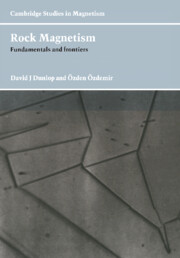Book contents
- Frontmatter
- Contents
- Preface
- Chapter 1 Magnetism in nature
- Chapter 2 Fundamentals of magnetism
- Chapter 3 Terrestrial magnetic minerals
- Chapter 4 Magnetostatic fields and energies
- Chapter 5 Elementary domain structures and hysteresis
- Chapter 6 Domain observations
- Chapter 7 Micromagnetic calculations
- Chapter 8 Single-domain thermoremanent magnetization
- Chapter 9 Multidomain thermoremanent magnetization
- Chapter 10 Viscous and thermoviscous magnetization
- Chapter 11 Isothermal magnetization and demagnetization
- Chapter 12 Pseudo-single-domain remanence
- Chapter 13 Crystallization remanent magnetization
- Chapter 14 Magnetism of igneous rocks and baked materials
- Chapter 15 Magnetism of sediments and sedimentary rocks
- Chapter 16 Magnetism of metamorphic rocks
- Chapter 17 Magnetism of extraterrestrial rocks
- References
- Index
Chapter 15 - Magnetism of sediments and sedimentary rocks
Published online by Cambridge University Press: 06 July 2010
- Frontmatter
- Contents
- Preface
- Chapter 1 Magnetism in nature
- Chapter 2 Fundamentals of magnetism
- Chapter 3 Terrestrial magnetic minerals
- Chapter 4 Magnetostatic fields and energies
- Chapter 5 Elementary domain structures and hysteresis
- Chapter 6 Domain observations
- Chapter 7 Micromagnetic calculations
- Chapter 8 Single-domain thermoremanent magnetization
- Chapter 9 Multidomain thermoremanent magnetization
- Chapter 10 Viscous and thermoviscous magnetization
- Chapter 11 Isothermal magnetization and demagnetization
- Chapter 12 Pseudo-single-domain remanence
- Chapter 13 Crystallization remanent magnetization
- Chapter 14 Magnetism of igneous rocks and baked materials
- Chapter 15 Magnetism of sediments and sedimentary rocks
- Chapter 16 Magnetism of metamorphic rocks
- Chapter 17 Magnetism of extraterrestrial rocks
- References
- Index
Summary
Introduction
The erosion products of igneous, sedimentary or metamorphic rocks are sources of detrital particles that go to make new sedimentary rocks. The detrital and post-depositional remanent magnetizations (DRM and PDRM) acquired when sediments are deposited and consolidated are no more than a reconstitution of the NRM's of detrital magnetic grains from the source rock (or rocks). Depending on the size and remanence mechanisms of grains in the source rocks, DRM may inherit the temperature and time stability and AF hardness of TRM, CRM, TCRM or VRM of SD, PSD, or MD grains.
DRM and PDRM are inherently weak, often < 10−3 A/m (10−6 emu/cm3). There are two reasons for this low intensity. First, dense oxide grains are less readily transported than silicate grains of similar size. Secondly, DRM represents only a partial realignment of original NRM vectors. With the advent of cryogenic magnetometers (Collinson, 1983), measuring the weak magnetizations of sediments and sedimentary rocks is no longer a major problem.
Red sedimentary rocks – so-called red beds – possess, in addition to depositional remanence, a CRM (10−3–10−1 A/m) carried principally by hematite pigment and cement. The CRM is useful paleomagnetically if the time at which the hematite formed is known.
The great attraction of sedimentary rocks is the comparative continuity of their magnetic record. Major igneous activity and metamorphism occur intermittently, sometimes at long intervals.
- Type
- Chapter
- Information
- Rock MagnetismFundamentals and Frontiers, pp. 425 - 460Publisher: Cambridge University PressPrint publication year: 1997

